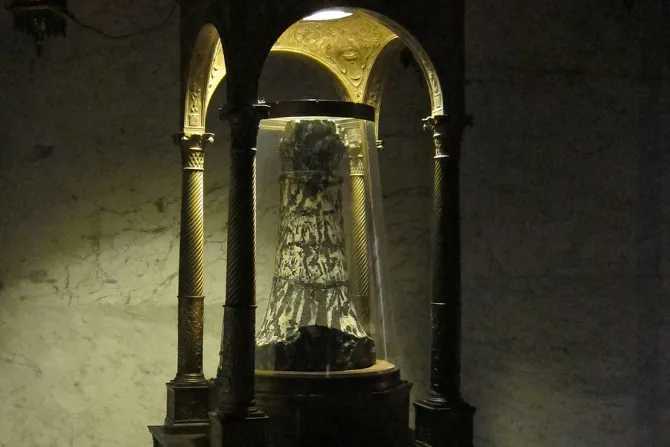Rome, Italy, Apr 14, 2017 / 00:51 am
In the hours after evening Mass of the Lord's Supper on Holy Thursday, a few pilgrims in Rome make their way to the Church of Saint Praxedes, home to a fragment of stone alleged to be the pillar upon which Jesus was scourged.
Known as the Column of the Flagellation, the stone offers an object of contemplation for those visiting the church to reflect on Christ's Passion. This is especially true on Holy Thursday, when pilgrims traditionally go to churches throughout the city to venerate the decorated altars within which the Eucharist has been reposed in anticipation of Good Friday.
The column is kept in a glass reliquary in one of the side chapels of Saint Praxedes, a 9th century church named after an early Christian martyr who has long-standing devotion in Rome, but about whom little is known for certain.
The pillar itself, sculpted from black-and-white marble, was retrieved from the Holy Land during the medieval period.
Is the artifact which continues to be visited by pilgrims as the column of the scourging a true relic of Christ's Passion? Most scholars would say this is highly doubtful.
Yet the probable in-authenticity of the pillar does not take away from the value in venerating it, says one expert. Rather, it is reminiscent of the genuine spirituality of medieval Christians, like those who found the pillar and brought it back from the Holy Land.
"The Middle Ages had a very powerful sense of God's Providence," said Gregory DiPippo, managing editor of the New Liturgical Movement website, "and to them you could almost say it was illogical that God would allow something like (the pillar) – which would have been Sanctified by being part of the Lord's Passion – to go missing."
Whether the true pillar of the flagellation still exists anywhere is uncertain. Jerusalem's Chapel of the Apparition claims to have the true pillar: a broken red porphyry column which bears no resemblance to the artifact in Rome.
However, in speaking of Saint Praxedes pillar, DiPippo explained it was improbable that the original would have survived on account of the 1st century uprisings which led to the destruction of Jerusalem.
Nonetheless, there is inherent value in venerating an object that may not be genuine, when one takes into account the objective of veneration, he added.
In the Western tradition, "you aren't venerating the object for its own sake, necessarily, but rather as an expression of a sort of realized presence of the person or the event that it represents."
This point is further illustrated by comparing Western and Eastern liturgical practices, he said, observing that in the West, the priest incenses the relics of the saints, whereas Byzantines incense the images and icons.
"It is the living presence, realized presence in this case, of the Passion of Christ," DiPippo said. "Even if it isn't authentic, we are still honoring the Passion of Christ by venerating it as such."
The pillar of Saint Praxedes was first brought to Italy by Cardinal Giovanni Colonna, a 13th century prelate appointed by Pope Innocent III, who had been serving as papal legate in the Holy Land during the sixth Crusade. Returning to Rome in the 1220s, he brought with him the column in question.
"One mustn't think of this as a conscious fraud on the part of Cardinal Colonna, or the people who received it as the relic of the flagellation," DiPippo explained, but rather of Medieval devotion.
This article was originally published on CNA April 3, 2015.



